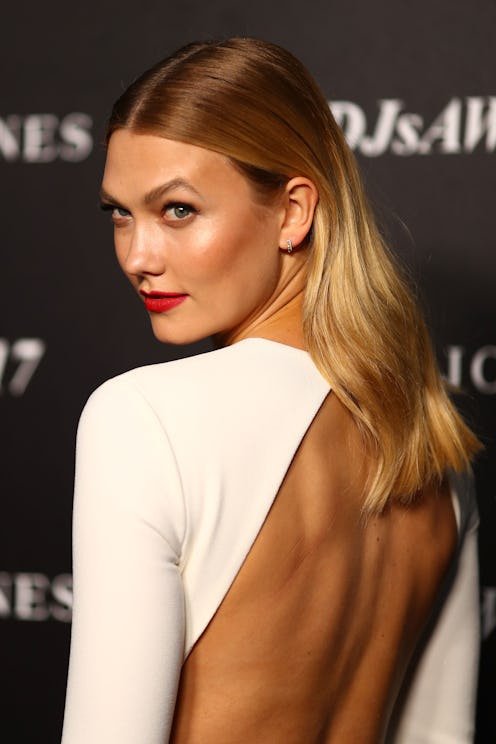
Just last week, Vogue made headlines across the country with its latest cover, which aimed at celebrating diversity — but some felt fell short of its goal. And the newest issue's controversies didn't stop there. Inside Vogue's March issue, Karlie Kloss is dressed as a geisha and accompanied by a sumo wrestler in a fashion spread. Kloss wears traditional Japanese dress, and in many of the images, her skin has been painted white to resemble the makeup of Japanese geishas and kabuki actors, in an unfortunate display of cultural appropriation.
Bustle has reached out to Vogue for comment, but did not immediately hear back.
Since the images of Kloss made their way to the internet, the model has apologized for their culturally insensitive nature and pledged to do a better job in the future of ensuring the projects she participates in focus on empowering and inspiring women. The apology has drawn mixed reactions on Twitter, ranging from people who appreciate the sentiment but never thought Kloss should have been faulted in the first place to others who insist an apology will never make up for the images. Either way, the shoot should be looked at critically and serve as a reminder for everyone to do better.
The whitewashing of Asian men and women is prevalent in nearly all forms of media. Recent examples include Tilda Swinton portraying the Ancient One in Marvel's Dr. Strange and Emma Stone playing a woman of Hawaiian and Asian descent in Aloha.
Arguably the most famous example of this type of appropriation happened in 2013, when Katy Perry's American Music Awards performance drew criticism for its Geisha-inspired theme. The performance all but drilled home the outdated, offensive stereotype of the submissive Asian woman, as Perry and her dancers tip-toed their way to their marks and continued to bow toward one another and the crowd throughout the performance. Perry took bits of a culture she is not a part of and used it as if it were her own.
Another example? Gwen Stefani. While Stefani's appropriation of Japanese culture did not include the geisha, forgetting her Harajuku Girls is difficult for anyone who grew up during the late 2000s. The four Japanese women followed Stefani through the launch of her first solo record as barely more than a stereotypical prop whose fashions she appropriated while also dressing them in harmful, stereotypical Japanese school girl skirts in her "What You Waiting For" music video and other public appearances. Alongside using the women as her backup, the women were even renamed by Stefani as Love, Angel, Music, and Baby after the album's title, and the four were contractually bond to only speak Japanese. The memory of Stefani's Harajuku Girls was so lasting that she was asked about the appropriation in 2014 as she became a coach on The Voice. In the interview with Time, Stefani explains that the Harajuku Girls were an homage to a culture she loved. Unfortunately, Stefani seemed to have not truly understood that by using silent, nameless Japanese women as props for a show reduces the Harajuku culture to a trend.
Comedian and writer Margaret Cho's 2005 blog post about the Harajuku Girls is a reminder that representations of Asian men and women have been so few that even the prop-like nature of the Harajuku Girls could be clung to. In it, Cho writes, "At least it is a measure of visibility, which is much better than invisibility. I am so sick of not existing, that I would settle for following any white person around with an umbrella just so I could say I was there." Now, Vogue has essentially committed the fashion equivalent by inserting a white woman into Japanese culture that she isn't a part of.
Social media users have been swift in their condemnation of the spread.
Kloss' apology regarding the shoot is a great start toward discussing Western media's fetishizing and exoticizing of cultures for profit. Thankfully, inclusive fashion content does exist for those seeking to find a more democratized take on style. Refinery29 has shown their commitment to body diversity through their See the 67 project which aims to showcase the 67 percent of women over size 16. In a video posted to the publication's Facebook in February, the brand announced that they would be reshooting their stock images, expanding their casting calls to include non-straight size models, and including plus size fashions in their product round-ups. Meanwhile, Teen Vogue has seriously ramped up representation on their covers. According to Fashionista, Teen Vogue's 2016 covers saw a 63.6 percent increase in featuring women of color on its cover. In fact, seven out of 11 covers featured women of color in 2016. We here at Bustle have also committed to diversifying the images we use in our content. While Vogue will always be heralded as one of the most renowned fashion magazines in the world, readers should know that there are other publications available who are steadily working to create a more inclusive space in the fashion and beauty world.